Use at Your Own Risk Disclaimers
One of the most commonly used disclaimers is the "use at your own risk" disclaimer. You've probably seen these all over the place, from the playground at the park, to the gym, to the parking lot at a giant mall, to websites and blogs.
When in an outdoor or physical location, these disclaimers are virtually impossible to miss because they're typically printed on big, bright signs:
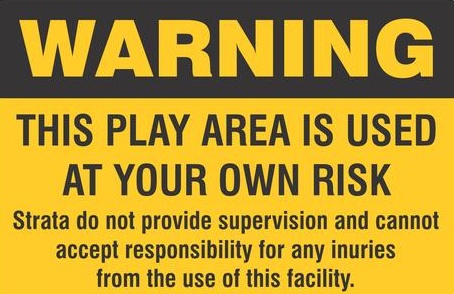
You've probably seen something like this at your local gym:
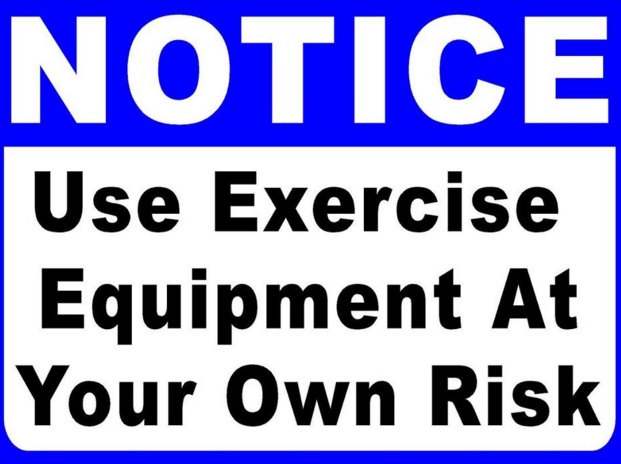
And if you've ever used public parking lots or garages, you've likely seen something like this one:
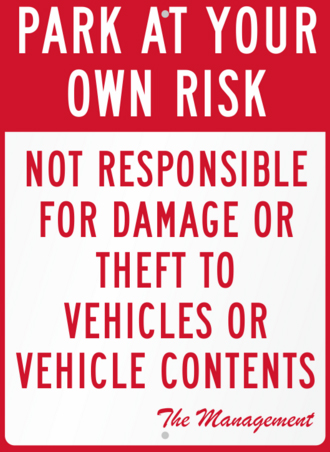
After all, it should be pretty obvious that store management isn't responsible for what may happen to your car out in the parking lot. Even if someone rams the side of your car with one of the store's shopping carts, you can't blame the store for it.
But use at your own risk disclaimers go further than just common sense. Any kind of disclaimer has one big purpose -- to limit or eliminate legal liability.
In this case, the owner of the playground, the owner of the gym, and the owner of the parking lot are all saying that you can't sue them if something happens.
But do these signs actually hold up in court?
In the US, it depends on what the disclaimer says, what actually happened, and what the state laws are. However, one thing that plaintiffs in lawsuits try to argue is that they didn't actually agree to the disclaimer. They didn't sign anything that waived their right to bring legal action like people do when they go skydiving, for example.
But a signature isn't the only way that a person can consent to a disclaimer.
In the case of use at your own risk disclaimers, a person's mere presence can be considered consent in the eyes of the law. After all, you saw the sign at the playground and still allowed your children to play there. Once you read the sign, you knew that the owner of the playground would refuse to compensate you if one of your kids got injured, you lost your wedding ring, or suffered some other kind of damage, but you didn't turn around and leave.
However, there are some basic guidelines to consider if you want the best chance at avoiding legal liability.
- First and foremost, your use at your own risk disclaimer needs to be prominent enough so that people actually know that it exists.
For example, install the playground sign right at the entrance, put the gym sign on the wall next to the front door, and attach the parking lot sign to various light poles in each row of cars.
Otherwise, someone may take you to court and argue that they weren't aware of your disclaimer.
- Make sure that the wording in your disclaimer is easy to understand.
In order to argue that people saw your use at your own risk sign and proceeded -- and, therefore, consented to your disclaimer -- the language on the sign has to be clear and simple. If it's chock full of legal jargon that the average person doesn't understand, you're going to have a very hard time convincing a court that you're not liable for anything.
- Don't do anything negligent.
A use at your own risk disclaimer won't protect you if you've committed some kind of negligence. For example, if you've known that the playground swingset has been broken for months and you haven't taken any steps to fix it or tell children not to use it, your use at your own risk disclaimer likely won't be much help in court. It's not a "get out of jail free" card that protects you from every possible threat.
- Understand what "foreseeable risk" means
Oftentimes, when someone is sued for negligence, they claim that the incident in question came with a foreseeable risk. Simply put, a foreseeable risk is a risk that a reasonable adult understands is possible as a result of their actions.
For example, when you go to the gym, you know it's possible that you could fall off the treadmill if you aren't paying attention to what you're doing. That's a foreseeable risk. But if the treadmill hasn't been properly maintained and the belt breaks in the middle of your workout, causing you to fall and cut open your chin, that's not a risk you could have seen coming.
As a result, the gym's use at your own risk disclaimer probably wouldn't hold up in court.
Do you need a Use at Your Own Risk Disclaimer?
It definitely can't hurt!
You don't have to provide a service that's considered dangerous or risky in order to benefit from one of these disclaimers. Even if you do something as simple as recommend a certain protein shake to your readers, a use at your own risk disclaimer may save you a lot of trouble later.
How?
Let's say that one of your readers goes out and buys the protein shake you recommended in your blog post. If she has a terrible reaction to it, she may want to blame you for any pain and suffering that she experienced. After all, if it wasn't for you, she never would have bought that protein shake.
If you had a use at your own risk disclaimer on your blog, you could simply say, "It's terrible that you had that reaction. However, that's why I warn all of my readers to use recommended products at their own risk. Just because that protein shake worked wonders for me doesn't mean that everyone else will have the same results."
Problem solved.
Some of the biggest names on the internet have published prominent use at your own risk disclaimers:
Like Wikipedia:

Remember, anyone can add information to a WIkipedia page. That's why the site warns visitors that the information can be "inaccurate, misleading, dangerous, addictive, unethical, or illegal." Since you've been warned that Wikipedia's content wasn't necessarily written by any kind of expert, you're using the information at your own risk. If, for example, you make an important medical decision after reading Wikipedia's page on strokes, the website isn't responsible for what may happen to you as a result.
And WebMD:

While WebMD articles might list a variety of tests and treatments that are used to diagnose and treat various illnesses, they make it clear in their disclaimer that they're not endorsing any particular diagnostic tools or courses of treatment. They come right out and say that if you're relying on the information they've published, you're doing so at your own risk.
And eBay:
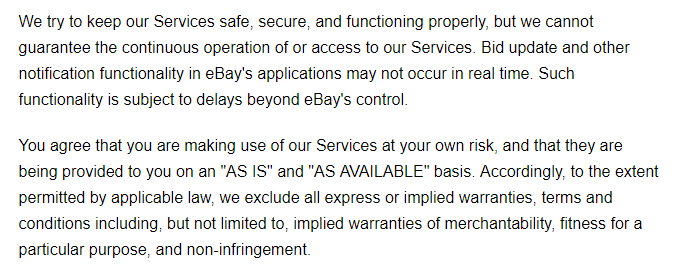
When buyers and sellers log into eBay, the company will do everything possible to have everything up and working. However, eBay admits that there are times when things go wrong, which is why it can't "guarantee the continuous operation of or access to" its services. In other words, if you miss out on a purchase because the bids weren't updating in real time, eBay isn't responsible.
But what if you don't own an online giant like these? What if you're simply a blogger or small business owner who needs to try to limit your legal liability?
Even if you think the odds of anyone trying to take you to court are slim, are you willing to bet your future on it?
Cecilia over at SnapHappy Foodie makes it clear that she's not legally responsible for what may happen in your kitchen if you try out one of her recipes:
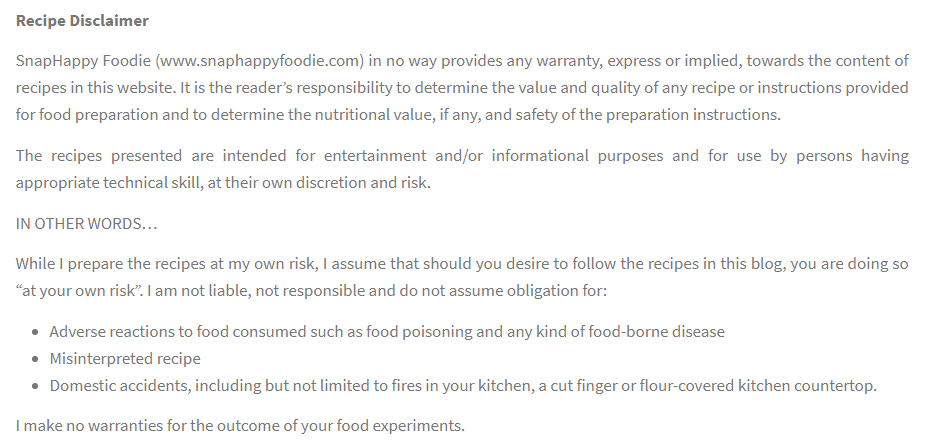
Over on Coupaw, a website that sells food, treats, toys, and health products for pets, there is a very clear use at your own risk disclaimer that applies to anything edible that you buy from them:

Not only does this disclaimer say that they're not liable for any "use or misuse" of their edible products, but they go a step further and say that you should assess the risk to your pet -- including a consultation with your veterinarian -- before you buy anything from them.
Sofia Skin Care Essentials is a small website that sells soaps, anti-acne kits, wrinkle creams, and other skin care products. But there's nothing small about the website's use at your own risk disclaimer. It's right on the homepage!
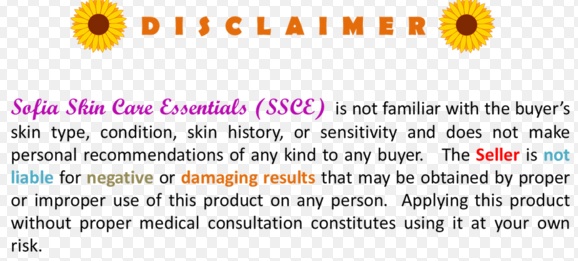
When the public school district in Temple, Texas, advertised their spring carnival in 2017, the promotion came with a use at your own risk disclaimer at the bottom:

Writing Your Use at Your Own Risk Disclaimer
- Think about what you're actually selling
Use at your own risk disclaimers are important whether you sell a physical product or an intangible service. However, the exact wording in your disclaimer will vary depending on what you're selling.
For example, if you're selling power tools, your use at your own risk disclaimer needs to mention injuries. Specifically, you're not responsible for any injuries that may happen when someone is using your tools.
On the other hand, if you're selling an eBook that readers need to download from your website, your use at your own risk disclaimer would likely include viruses. For example, you may tell your customers that they're downloading the eBook at their own risk, so if they happen to get a computer virus in the process, you're not legally liable for it.
- Think about the liability you could face
There are all kinds of issues that may pop up, so try to think of every possible problem that someone may try to hold you liable for. It's better to have a longer use at your own risk disclaimer than to have one that overlooks a major risk!
For example, if you accept comments on your blog, you may want to include a disclaimer like the one Google uses. While you reserve the right to remove offensive comments, you're not liable if one of your blog's visitors is offended by what a commenter said.
- Think about using the phrase "including, but not limited to"
Even if you think you've accounted for all of the possible types of liability you might face, the best way to cover your bases is to include the phrase "including, but not limited to" in your disclaimer.
For example, if you're writing a disclaimer for the sauna at your hotel, you might say something like, "Using this sauna may subject you to health issues including, but not limited to, dehydration, increased body temperature, burns, and fungal infections. Use at your own risk. Owner is not liable for any injuries or illnesses that occur."
- Think about any third-parties that you work with
Let's say you're a party planner who hires florists, DJs, and caterers. Since you have no control over those other businesses, you might want to mention them in your use at your own risk disclaimer.
For example, you may want to say something like, "The food at your event will be provided by a third-party catering service. Eat at your own risk, as party planner is not responsible for any illnesses or adverse reactions that result."